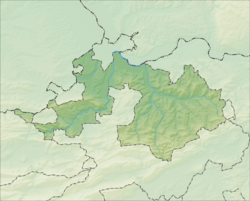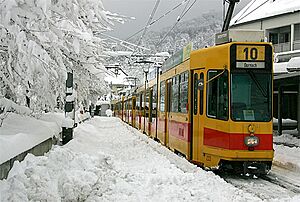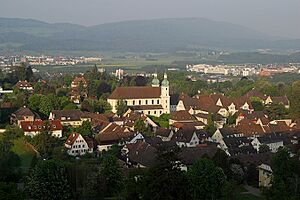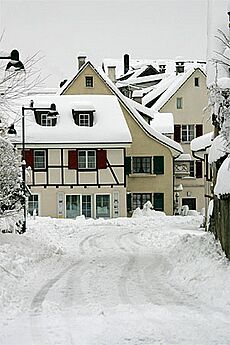Arlesheim facts for kids
Quick facts for kids
Arlesheim
|
||
|---|---|---|
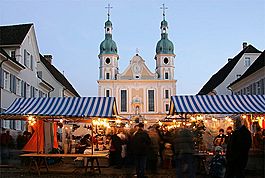
Market on Domplatz in front of the Dom
|
||
|
||
| Country | Switzerland | |
| Canton | Basel-Landschaft | |
| District | Arlesheim | |
| Area | ||
| • Total | 6.93 km2 (2.68 sq mi) | |
| Elevation
(Domplatz)
|
334 m (1,096 ft) | |
| Population
(Jun 2021 )
|
||
| • Total | 9,240 | |
| • Density | 1,333.3/km2 (3,453/sq mi) | |
| Demonym(s) | German: Arlesheimer(in) | |
| Postal code |
4144
|
|
| Surrounded by | Dornach (SO), Gempen (SO), Münchenstein, Muttenz, Reinach | |
Arlesheim is a town and a municipality in Switzerland. It's located in the Basel-Country canton, within the Arlesheim district. The town is famous for its beautiful Cathedral, which is a very important historical site.
People in Arlesheim mainly speak Swiss German, which is a type of German. The Cathedral has a special Baroque organ built in 1761. This organ mixes French and German styles and has been used in many music recordings.
Contents
History of Arlesheim: A Journey Through Time
Arlesheim was first mentioned way back in the year 708. Later, in 1239, it was called Arlisheim.
Early Settlements: Life in Ancient Arlesheim
The area where Arlesheim is located was a good place for early people to live. This is because it was protected by the Gempen Plateau.
- Stone Age Discoveries: Tools and items from the Stone Age (around 10,000 BC) were found in caves like Birseck–Ermitage. These included spear points made from reindeer antlers and pendants from shells.
- Flint Tools and Burials: Later, more flint tools were found. Some ancient burial items were also discovered, showing how people lived and died long ago.
- Bronze Age: A few items from the Bronze Age have been found, but nothing from the Iron Age so far.
Medieval Times: Bishops and Churches
In the 8th century, a monastery owned the land of Arlesheim.
- Bishop's Land: In 1239, the land was sold to the Bishop of Basel. The Bishop officially owned Arlesheim by 1435.
- Local Church: By 1341, Arlesheim had its own church, St. Odilia. It even had its own pastor by 1396. This church was rebuilt later but was taken down in 1816.
From Reformation to Modern Era
Arlesheim was influenced by the city of Basel. When Basel became Protestant in 1528, Arlesheim also changed its religion.
- Counter-Reformation: However, in 1582, the Bishop of Basel brought back the Catholic faith to Arlesheim.
- Quiet During War: During the Thirty Years War, Arlesheim was mostly safe from fighting because it was off the main roads. It was a small village known for growing grapes for wine.
- New Buildings: In 1678, the Basel cathedral council and priests moved to Arlesheim. They built an administrative center and grand Baroque buildings, including the Cathedral (1679–1681). These new buildings made Arlesheim a popular place for important people, artists, and craftspeople.
- English Garden: In 1785, a large English garden called the Eremitage (Hermitage) was created. It became famous across Europe and attracted many visitors.
French Influence and Growth
From 1793 to 1814, Arlesheim was under French rule.
- Saving the Cathedral: During this time, the Cathedral was taken over by the government. But brave citizens bought it to stop it from being destroyed. Later, the church bought it back, and it became a parish church.
- Joining Basel-Country: In 1815, Arlesheim became part of the Canton of Basel. When the canton split in 1832, Arlesheim joined Basel-Country and became a district capital.
- New Industries: The French invasion caused some economic problems. But in 1830, the first mechanical silk factory in Switzerland opened in Arlesheim. This factory operated for almost 150 years.
- Transportation Links: In 1875, a railway line opened, followed by a tram line in 1902. These transport links helped new businesses grow, like an electric equipment company and companies making natural remedies.
- Growing Town: Arlesheim's mild climate and sunny vineyards made it a popular place for vacation homes. More people moved to Arlesheim, making it a residential area for the larger Basel region.
Geography: Where is Arlesheim?
Arlesheim covers an area of about 6.93 square kilometers (2.67 square miles).
- Land Use: About 9.4% of the land is used for farming, and 52.5% is covered by forests. Buildings and roads make up about 38.2% of the area.
- Location: The town is the capital of its district. It's located in the Birseck area, which is the lower valley of the Birs river. Arlesheim has grown and is now part of the larger Basel city area.
Coat of Arms
The coat of arms for Arlesheim shows a blue wing on a silver background.
Population and People
Arlesheim has a population of about 8,954 people.
- Languages: Most people (about 86.1%) speak German. Italian is the second most common language (3.3%), followed by French (1.9%).
- Diversity: In 2008, about 18.8% of the people living in Arlesheim were foreign nationals.
- Age Groups: The population includes about 6.2% children (0-6 years old) and 13.6% teenagers (7-19 years old). A large part of the population is adults and seniors.
The historical population is shown in the chart below:

Important Heritage Sites
Several places in Arlesheim are listed as very important national heritage sites.
- Historic Buildings: These include the Andlauerhof, the Domherrenhaus (Canon's House) at Domstrasse 2, and the Domherrenhäuser (Canon's Houses) at Domplatz.
- Cathedral Church: The Cathedral itself is a major site.
- Hermitage and Castles: The Hermitage site, which has the ruins of Birseck Castle and ancient cave dwellings, is also important. Reichenstein Castle is another significant historical place.
- Swiss Heritage: The entire village of Arlesheim is part of the Inventory of Swiss Heritage Sites, meaning it's a protected historical area.
Economy: How People Work in Arlesheim
Arlesheim has a low unemployment rate, which is good!
- Job Sectors: In 2005, most jobs were in the service sector (like shops, offices, and healthcare). There were also jobs in the manufacturing and agriculture sectors.
- Types of Jobs: Many people work in sales, transportation, hotels, finance, and healthcare.
- Commuting: Many people who live in Arlesheim travel to other places for work. Also, many people from outside Arlesheim come to work here.
- Transportation to Work: About 31.3% of workers use public transportation to get to their jobs, while 35.9% use a private car.
Religion
According to the 2000 census:
- About 36.3% of the population were Roman Catholic.
- About 32.9% belonged to the Swiss Reformed Church (Protestant).
- Smaller numbers of people belonged to other Christian churches, or were Muslim, Jewish, Buddhist, or Hindu.
- About 18% of the population did not belong to any church.
Transport
Arlesheim has good transport links:
- Train Station: It's on the Basel–Biel/Bienne railway line and has a train station called Dornach-Arlesheim.
- Tram: The town is also served by Line 10 of the Basel tramway network, making it easy to travel around.
Education
Education is important in Arlesheim.
- Higher Education: About 37.6% of the population has finished upper secondary education (like high school). About 22.6% have gone on to higher education, such as university.
- Student Mobility: In 2000, 186 students came to Arlesheim for school from other towns. Also, 458 residents of Arlesheim went to schools outside the municipality.
Notable People
Many interesting people have connections to Arlesheim:
- Johann Baptist Stuntz (1753 in Arlesheim – 1836), a Swiss-German painter.
- Emil Frey (1838 in Arlesheim – 1922), a Swiss politician who was also a soldier in the American Civil War.
- Andreas Heusler (1865–1940), a Swiss expert in Germanic and Norse studies, lived in Arlesheim from 1920.
- Adolf Grabowsky (1880 – 1969 in Arlesheim), a German political scientist.
- Wilhelm Pelikan (1893 — 1981 in Arlesheim), a chemist and gardener, lived in Arlesheim from 1965.
- Max Jordan (1895-1977), a pioneering radio journalist, lived in Arlesheim from 1931–1939.
- Annemarie Düringer (1925 in Arlesheim – 2014), a Swiss actress.
- Barbara Berlusconi (born 1984 in Arlesheim), a business executive.
Images for kids
-
Domkirche (Cathedral Church)
See also
 In Spanish: Arlesheim para niños
In Spanish: Arlesheim para niños




